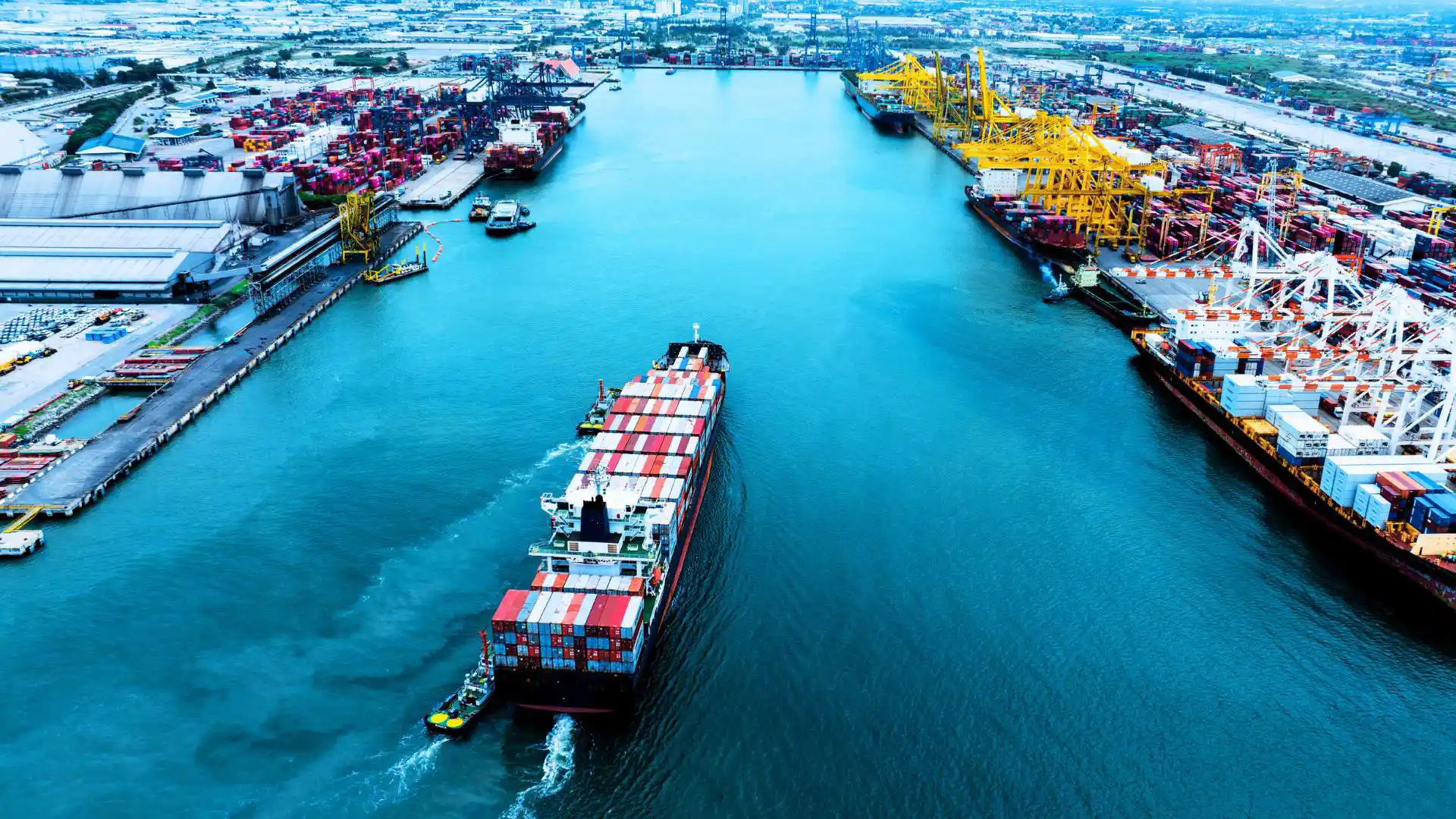Welcome to the 10th Annual State of the North American Supply Chain Survey. This milestone edition reflects the perspectives of over 1,000 shippers from diverse shipper industries, providing a comprehensive outlook on the challenges and opportunities shaping 2025.
Over the past decade, supply chains have undergone transformative changes, from adapting to global disruptions to embracing emerging technologies. As we embark on 2025, this white paper continues to serve as a critical resource, offering actionable insights to help shippers navigate the complexities of the modern logistics landscape.
With data-driven analysis, industry trends, and expert recommendations, we aim to equip you with the tools and knowledge to build resilient, efficient, and forward-thinking supply chain strategies.

GENERAL ECONOMIC OUTLOOK FOR THE INDUSTRY
As we enter 2025, optimism among shippers is on the rise. In our latest State of the North American Supply Chain Survey, 69.73% of respondents anticipate an increase in shipping volumes compared to 2024 - a slight but meaningful uptick from last year’s 66.57%. Meanwhile, the percentage of respondents expecting a decrease in shipping volumes has fallen to just 5.69%, down from 7.95% in 2024. This positive sentiment reflects a cautiously optimistic view of the economic landscape and the role it will play in shaping supply chain activity over the next 12 months.

CORRELATION WITH BROADER ECONOMIC TRENDS
This outlook aligns with broader economic analyses, which suggest the U.S. economy may outperform expectations in 2025. According to a November 2024 outlook from Goldman Sachs, strong labor markets, sustained consumer spending, and cooling inflation are driving confidence in economic growth. Shippers’ anticipation of increased volumes mirrors this momentum as businesses prepare for heightened activity across industries.

A BALANCED PERSPECTIVE: HEADWINDS TO CONSIDER
While the survey results and economic projections provide cause for optimism, shippers should approach 2025 with cautious preparation. Macro-level challenges remain, including:
The uncertainties surrounding a new presidential administration, which could introduce shifts in trade and economic policies.
The looming threat of tariffs, particularly on imports from key trade partners, which could disrupt supply chain costs and strategies.
Ongoing geopolitical disputes, which continue to pose risks to global trade flows and supply chain stability.
These factors underscore the importance of contingency planning and agility in supply chain operations. While the outlook for 2025 suggests growth and opportunity, businesses must remain vigilant and adaptive to navigate potential disruptions effectively.
WHAT 2025 HOLDS FOR FREIGHT PRICING
Shippers are preparing for a dynamic market in 2025, with survey results indicating a notable shift in expectations for shipping rates. This year, 57.44% of respondents anticipate rate increases, compared to 51.89% in 2024. Additionally, those predicting no change fell to 26.24% from 37.47%, while 16.32% expect a decrease, up from 10.64%. These figures highlight a complex supply chain environment shaped by economic recovery, tightening capacity, and regulatory impacts.

Factors Influencing Rate Increases
Economic Recovery and Freight Demand: Economic momentum is a key driver behind the expectation of rising rates. As reported by FreightWaves this past November, the freight market is poised for recovery in 2025, with increased consumer activity and industrial production fueling demand. This growth puts pressure on available capacity, particularly in sectors like LTL, where tighter supply often translates into higher rates.
Capacity Challenges and Driver Shortages: A significant challenge facing the industry is the availability of drivers. The FMCSA Drug and Alcohol Clearinghouse recently enacted stricter regulations, potentially removing up to 177,000 drivers from the labor pool. While this impact will predominantly affect the
truckload sector, LTL capacity could also feel the strain, further driving rate increases as shippers compete for available resources.
Geopolitical and Policy Uncertainty: Regulatory changes, including the potential implementation of new tariffs under the current administration, add complexity to trade flows. Geopolitical tensions and shifting sourcing strategies, including nearshoring and reshoring, are likely to influence logistics costs and drive variability in shipping rates.

Strategic Responses to Rising Rates
Shippers and logistics service providers are taking proactive steps to address these challenges and minimize the impact of increasing costs:
Strengthening Partnerships: Collaborating with logistics providers that offer integrated services to improve efficiency and reduce waste.
Technology Adoption: Utilizing predictive analytics and capacity management tools to optimize routes and identify cost-saving opportunities.
Diversifying Modal Options: Exploring multi-modal solutions, including rail and air, to balance speed and cost-effectiveness.
2025 will also usher in a new era of operational changes for shippers and carriers as the National Motor Freight Traffic Association will tentatively implement significant modifications to LTL freight
classifications, shifting to a more streamlined, density-focused model. It’s important that shippers engage with their carriers to understand how these changes may impact their rates and shipment planning going forward. Visit our website to learn more or check out the NMFTA’s 2025 Classifications page.
PREPARING FOR 2025 WITH CONFIDENCE
The prospect of rising shipping rates underscores the importance of strategic planning and adaptability. By aligning with logistics partners that offer comprehensive solutions, shippers can mitigate risks and maintain operational efficiency. The road ahead may bring challenges, but businesses that plan for capacity constraints and regulatory changes today will be better positioned to succeed in the evolving supply chain landscape.

Cross-Border Trends Shaping Supply Chains in 2025
The results of this year’s survey reveal minimal changes in planned shipping activity across North America. When asked if they anticipate shipping to or from key locations in 2025, 46.54% of respondents cited Canada (slightly down from 46.84% in 2024), 35.12% identified Mexico (up from 33.83%), and 18.34% mentioned Puerto Rico (a modest decline from 19.33%). While these figures suggest stability, underlying factors, including potential tariff changes, and sourcing strategies, could drive more significant shifts in the future.
Shipping to or from Puerto Rico? Watch the video below or visit our Puerto Rico Services Page to learn how Averitt can help you ship to and from the island with ease!
The Influence of Tariffs on Cross-Border Trade
Trade relations within North America remain central to supply chain planning. However, the possibility of new tariffs under the current administration could complicate the flow of goods between the U.S., Canada, and Mexico. As Time reports, proposed tariffs may target critical imports, prompting businesses to reassess their sourcing and distribution strategies to mitigate cost increases. This uncertainty highlights the importance of adaptability and contingency planning for shippers.
Furthermore, price adjustments by major retailers in response to these potential tariffs signal broader implications for supply chains reliant on cross-border trade. Increased costs for raw materials and
finished goods could result in higher consumer prices, underscoring the need for proactive logistics strategies.
Nearshoring and Reshoring: Mitigating Risk and Capitalizing on Opportunity
With tariffs and geopolitical tensions continuing to create uncertainty, nearshoring and reshoring are emerging as viable alternatives for businesses looking to reduce dependency on overseas supply chains. Mexico offers an attractive option due to its proximity, established trade agreements, and skilled labor pool. This trend aligns with the modest increase in shippers planning to engage with Mexico in 2025, as highlighted in our survey.
Additionally, companies are increasingly leveraging reshoring strategies to bring production closer to their end markets. This approach not only reduces transportation costs but also minimizes exposure to geopolitical risks and trade barriers.

Strategic Planning for Cross-Border Success
While the 2025 survey results indicate relative stability in shipping activity across North America, the evolving trade landscape demands vigilance and strategic planning. Shippers can navigate these challenges by:
Strengthening Cross-Border Capabilities: Aligning with logistics providers that offer seamless services for imports and exports across North America.
Monitoring Trade Policy Changes: Staying informed about potential tariffs and trade negotiations that could impact costs and operations.
Exploring Nearshoring and Reshoring: Evaluating production and sourcing opportunities closer to home to enhance supply chain resilience.
The North American trade environment is poised for both challenges and opportunities in 2025. By planning and leveraging innovative logistics solutions, businesses can position themselves for success in an ever-changing marketplace.
Shipping to or from Mexico? Watch the video below or visit our Mexico Services Page to learn how Averitt can help you ship to and from Mexico with ease!
A SLIGHT SHIFT IN PORT PREFERENCES
The 2025 survey reflects slight shifts in shipping preferences through U.S. ports, with the West Coast seeing a modest increase in usage from 33.06% to 36.04%, while the East Coast dipped slightly from 43.68% to 42.12%, and the Gulf Coast declined from 23.26% to 21.85%. It’s important to note that most survey respondents are based in the Eastern U.S., which heavily influences the reliance on East and Gulf Coast ports.
Labor Uncertainty: A Persistent Concern
Labor disruptions have significantly shaped port usage trends. The 2024 International Longshoremen’s Association (ILA) strike prompted shippers to diversify their strategies to avoid risks associated with East and Gulf Coast ports. Shippers were also put on full alert this January when the possibility of a second ILA strike arose. Fortunately, a deal was negotiated before the pending strike’s deadline.
While East and Gulf Coast ports remain essential due to their proximity to many shippers, labor-related uncertainties could push more businesses to consider West Coast ports or alternative routes.
West Coast Growth: A Strategic Shift
The slight increase in West Coast usage highlights its ongoing importance, particularly for goods sourced from Asia. Despite previous congestion and labor disputes, investments in infrastructure and automation have strengthened the region’s capabilities, making it an attractive option for shippers
balancing risk across multiple ports.
Environmental Challenges: Panama Canal Recovery
The Panama Canal, a vital route for East and Gulf Coast shipments, faced significant supply chain disruptions due to a two-year drought that limited its capacity. However, with recovery efforts underway, officials expect cargo volumes to stabilize and improve over time. This improvement will likely bolster East and Gulf Coast port usage in the long term.

STRATEGIC CONSIDERATIONS FOR SHIPPERS IN 2025
For businesses navigating port selection, the following strategies are critical to building resilience:
Leverage Proximity to Markets: For shippers in the Eastern U.S., East and Gulf Coast ports remain essential, but diversifying usage can mitigate risks.
Explore Multiple Port Options: Diversifying across coasts and port facilities reduces reliance on any single location and helps manage labor and environmental challenges.
Collaborate with Logistics Providers: Work with partners that offer integrated, end-to-end solutions and can adapt to changes in the supply chain landscape.
As shippers approach 2025, the ability to anticipate and adapt to labor disputes, environmental shifts, and geographic dependencies will be vital. Strategic planning and partnerships can ensure operational efficiency and position businesses for success in a complex and evolving logistics environment.
Our asset-based fleet of chassis has your port transportation needs covered! Watch the video below or visit our PortSide Services Page to learn how Averitt can streamline your inbound cargo needs!
TRACKING SHIFTS IN IMPORT ORIGINS: A GLOBAL PERSPECTIVE
Over the years, significant shifts have occurred in the primary points of origin for U.S. imports, driven by evolving economic, political, and supply chain dynamics. Comparing data from 2018, 2024, and 2025 reveals key trends that reflect how U.S. businesses are diversifying their sourcing strategies.
The Decline of Chinese Imports
China has remained a dominant player in U.S. imports, but its share has steadily decreased from 40.58% in 2018 to 34.63% in 2025. This trend aligns with ongoing geopolitical tensions, tariffs, and increasing labor costs, prompting U.S. businesses to explore alternative sourcing locations.
For example, India and neighboring South Asian nations have emerged as attractive alternatives. India’s share of U.S. imports has grown significantly, rising from 6.07% in 2018 to 9.16% in 2025. Neighboring countries such as Vietnam and Bangladesh are also capturing market share, benefitting from the shifting trade landscape between the U.S. and China.
The Rise of Europe
Europe’s share of U.S. imports has experienced notable growth, increasing from 12.09% in 2018 to 16.42% in 2025. This growth reflects strong trade partnerships and Europe’s ability to provide high-quality, diversified products. Additionally, U.S.-Europe trade ties remain bolstered by stable geopolitical relations and shared investment in clean energy and technology sectors.
INDIA AND SOUTH KOREA: EMERGING SUPPLY CHAIN HUBS
India’s consistent growth in the U.S. market showcases its rising prominence in global trade. As the country continues to invest in its manufacturing infrastructure, neighboring nations such as Vietnam and Bangladesh are also positioning themselves as key suppliers to the U.S. market. Similarly, South Korea has seen incremental growth, increasing from 3.96% in 2018 to 5.47% in 2025, driven by its strengths in technology and automotive industry exports.
Strategic Takeaways
Diversification of Supply Chains: Businesses are increasingly sourcing from multiple regions to mitigate risks associated with geopolitical tensions and reliance on a single country.
Focus on Resilience: The rise of India, Europe, and South Korea reflects the ongoing quest for resilience and cost efficiency in global supply chains.
Nearshoring Opportunities: Mexico and Canada remain vital partners, offering proximity and reliability for U.S. businesses seeking nearshoring options.
As U.S. businesses adapt their supply chains in 2025, strategic partnerships with logistics providers will be essential to navigate these evolving global trade dynamics effectively.


SUSTAINABILITY: A GROWING PRIORITY IN DECISION-MAKING
As businesses increasingly prioritize environmental responsibility, the importance of a carrier’s sustainability program continues to grow. In 2025, 47.54% of survey respondents indicated that sustainability plays a “high” role in their decision-making process - a modest increase from 46.03% in 2024. While the change may appear incremental, it reflects a consistent upward trend in how sustainability shapes logistics partnerships.
Why Sustainability Matters
Several factors are driving the growing emphasis on sustainable practices in supply chain management:
Investor Pressure: A report from MIT highlights the rising influence of investors pushing businesses to adopt environmentally responsible practices. Companies are being evaluated not just on financial metrics but also on their commitment to sustainability.
Consumer Expectations: Customers increasingly value brands that align with their environmental values. A commitment to sustainability can enhance brand loyalty and attract environmentally conscious consumers.
Global Regulations: Governments worldwide are imposing stricter environmental standards, requiring companies to adopt greener practices to remain compliant.

Averitt's Distribution and Fulfillment Centers are equipped with electric tow-motors.
Logistics’ Role in Sustainability
The supply chain is a critical area for businesses seeking to reduce their carbon footprint. Transportation and logistics providers have a unique opportunity to lead sustainability efforts by investing in clean energy, optimizing routes, and adopting technologies that improve fuel efficiency.
AVERITT’S SUSTAINABILITY COMMITMENT
At Averitt, sustainability is a core value integrated into every aspect of our operations. Our initiatives include:
Carbon Emission Reduction: By utilizing fuel-efficient equipment and optimizing routes, we actively reduce greenhouse gas emissions across our network.
Clean Energy Investments: Our facilities incorporate energy-saving technologies, including LED lighting and energy-efficient HVAC systems.
Eco-Friendly Practices: From recycling programs to electric forklifts, our distribution and fulfillment centers are designed with sustainability in mind.

The Business Case for Sustainability
Investing in sustainability is not just good for the environment; it’s good for business. According to a Forbes report, integrating sustainability into supply chains can reduce costs, improve operational efficiency, and attract more customers. For shippers, working with environmentally conscious carriers can also enhance their own ESG (environmental, social, and governance) metrics.
Strategic Takeaways
Differentiator: Carriers with strong sustainability programs are increasingly viewed as preferred partners by shippers.
Building Resilience: Sustainable practices not only reduce environmental impact but also enhance long-term resilience by mitigating risks related to resource scarcity and regulatory compliance.
Continued Investment Needed: As sustainability remains a high priority for nearly half of shippers surveyed, carriers must continue to innovate and
invest in green technologies.
Sustainability is no longer a secondary consideration - it’s a key factor influencing supply chain strategies. As shippers plan for 2025, partnering with logistics providers committed to environmental stewardship will be essential in meeting the growing demand for greener supply chains.
CONCLUSION: BUILDING RESILIENCE FOR 2025 AND BEYOND
As this year’s survey highlights, the North American supply chain is poised for growth, yet it faces
a dynamic mix of opportunities and challenges. From adapting to shifting trade landscapes to leveraging technological advancements, the decisions made today will shape the resilience and efficiency of supply chains for years to come.
Averitt’s Power of One approach underscores the importance of collaboration and integration in meeting these challenges head-on. By aligning with trusted logistics partners, embracing innovation, and planning for contingencies, businesses can turn potential risks into strategic advantages.
The path forward requires adaptability and vision. Together, we can build stronger supply chains, ensuring success in 2025 and setting the stage for sustainable growth in the years ahead.










.webp?width=1920&height=1080&name=supply-chain-circle-2023%20(4).webp)




